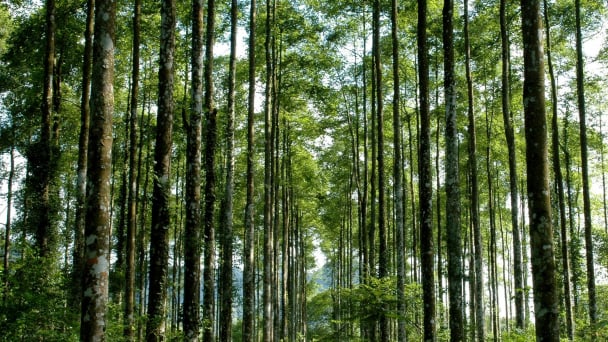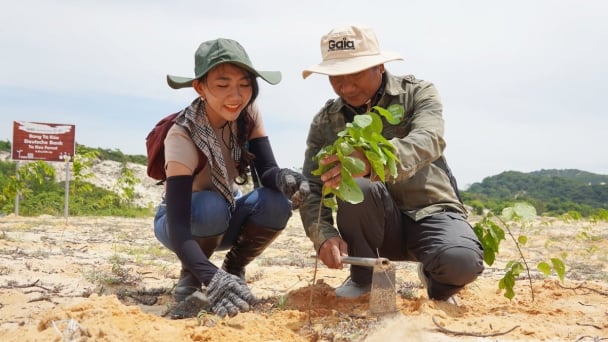September 2, 2025 | 16:05 GMT +7
September 2, 2025 | 16:05 GMT +7
Hotline: 0913.378.918
September 2, 2025 | 16:05 GMT +7
Hotline: 0913.378.918
Prof. Dr. Pham Hong Giang has held the office of Deputy Minister of Agriculture and Rural Development (now the Ministry of Agriculture and Environment) since 1997, during which the irrigation sector undertook research, investment preparation, and the construction of numerous large-scale reservoirs, particularly in the Central Vietnam heartland, such as Cua Dat (Thanh Hoa province), Dinh Binh (former Binh Dinh, now Gia Lai province), and Ta Trach (Hue). Behind these monumental projects lie countless exciting stories, which Prof. Pham Hong Giang shared with reporters from the Agriculture and Nature Newspaper.

Prof. Dr. Pham Hong Giang, former Deputy Minister of Agriculture and Rural Development, shared with reporters from the Agriculture and Nature Newspaper his memories of constructing large reservoir projects in Central Vietnam.
It can be said that no two irrigation structures are alike. As a result, each structure leaves me with distinct impressions, memories, and lessons, regardless of whether it is a large-scale or small-scale one.
Perhaps the most impressive projects for me are the series of reservoir dams across the Central Vietnam region. These works applied the latest technologies, leaving an imprint not only on the sector but also on the nation.
The first project is the Cua Dat reservoir, the tallest embankment dam with a concrete-faced rockfill in Southeast Asia. Previously, Vietnam had the Rao Quan hydropower plant in Quang Tri province, built with the same type of dam, but its height did not exceed 90 meters. In contrast, the Cua Dat dam reaches 118 meters. For a concrete-faced rockfill dam, even a relatively modest increase in height involves addressing a series of complex technical issues, requiring thorough research, testing, and meticulous preparation from design to construction. Thus, no other dam of this type in Southeast Asia has ever reached a height of 118 meters.

The Cua Dat reservoir features a 118-meter-high dam constructed with concrete-faced rockfill technology. Photo: Dong Thai.
In earlier stages, although many experts in the irrigation sector had considered building rockfill dams, no one dared to proceed due to the lack of suitable construction technology and equipment, particularly the absence of sufficiently powerful compactors capable of firmly compressing the rock.
In addition, I have particularly special memories of constructing the Dinh Binh reservoir dam in the former Binh Dinh province, as it was Vietnam's first proposed roller-compacted concrete (RCC) dam. An outstanding advantage of RCC is its minimal cement usage, substituting fly ash from thermal power plants, which reduces heat-generating hydration within the concrete mass and allows continuous layering similar to earth dams. Each layer of concrete is compacted tightly using 30–40-ton rollers, so the progress of completion is very rapid.
Previously, irrigation dams were built using conventional concrete, mixing cement with aggregates such as sand and gravel to form concrete blocks. However, the hydration process of this concrete type generates a large amount of heat, which can easily cause cracks in the dam body. Moreover, construction could not proceed continuously; the next block had to wait for the previous block to harden, making the process very time-consuming.

The Dinh Binh reservoir (former Binh Dinh province, now Gia Lai province) was constructed using roller-compacted concrete technology.
I remember that in 1999, a severe flood occurred in the Central provinces. After the flood, Prime Minister Phan Van Khai held a meeting in Thua Thien–Hue. The Prime Minister called me over and asked, "Let's consider large reservoirs that the Central region needs and list them for me." During that meeting, he immediately decided to implement the projects, including the Ta Trach and Dinh Binh dams.
Although the Dinh Binh project had been included in the investment portfolio, constructing the dam was an extremely challenging process. According to the original design, the dam was to be built with conventional concrete. Switching to roller-compacted concrete left the design unit "at a loss," as they had never undertaken such a project before. Implementing it would require surveying, measuring, calculations, research, and a complete redesign while lacking funds. Moreover, at that time, no construction company in Vietnam had experience with roller-compacted concrete; even Construction Company 47, one of the most capable and reputable builders, was hesitant and unwilling to take on the project.
Not only were the design and construction units concerned, but Binh Dinh province was also anxious, as using roller-compacted concrete would require trials, making the process lengthy and exhausting. Consequently, the local government did not agree.

The non-overflow dam on the right side of the Dinh Binh reservoir. Photo: Tuan Anh.
From the management perspective of the Ministry of Agriculture and Rural Development at the time, we believed that without applying roller-compacted concrete, the irrigation sector would fall behind, while the world was already advancing with numerous projects. Therefore, Ministry leadership was decisive, telling the design unit, "Follow our requirements and proceed; whatever funding you need, we will provide it. Only then did the designers commit to the project.” As for the construction contractor, the Ministry assured them that any travel, research, or training expenses would be covered. Consequently, the construction unit organized study visits to China. They studied with great seriousness and dedication, and upon returning to Vietnam, performed their work exceptionally well.
After completing the Dinh Binh dam, a quality inspection team from Switzerland came to conduct on-site testing. They found our roller-compacted concrete to be of such high quality that they took samples back to display in glass cases at their headquarters in Switzerland.
The Ta Trach Reservoir was also a project mandated by Prime Minister Phan Van Khai following the flood of 1999, in which Thua Thien-Hue was the hardest-hit locality. Initially, the Ministry of Agriculture and Rural Development sought Official Development Assistance (ODA) funding from Japan. Experts from JICA conducted detailed surveys and assessments with a view to providing financial support; however, for various reasons, the plan could not be realized.
Ultimately, the Ministry of Agriculture and Rural Development proposed to the Government to use domestic funds for the project, and the Prime Minister approved. Fortunately, central agencies and branches implemented the Prime Minister's directives decisively, and the local governments acted very responsibly. The Provincial Party Secretary at that time even told us, "Whatever needs to be done to build this dam, I will do it."
The conditions for building the dam at that time were not simple, as it was located on a geologically complex foundation. The Department of Construction Management seconded Mr. Nguyen Hoang Nam as Director of the Irrigation Investment and Construction Management Board No. 5 in charge of the site, which ensured the dam’s successful construction. In fact, during major floods in recent years, the Ta Trach reservoir has played a highly effective role in flood prevention for downstream areas. According to calculations by specialized agencies, without the flood-regulating function of the Ta Trach reservoir, during the historic flood at the end of October 2020, Hue City would have been submerged an additional 1.2 meters.

The Ta Trach reservoir during the flood season. Photo: Nguyễn Phong.
The projects I have mentioned above are all closely associated with the process of listening and seizing new science and technology while learning from experience to apply such knowledge creatively to each specific position of the irrigation structure.
The irrigation sector is receiving special attention from the Party and the State. Specifically, the Politburo issued Conclusion No. 36/KL-TW dated June 23, 2022, on ensuring water security and the safety of dams and reservoirs by 2030, with a vision to 2045. Most recently, on July 14, 2023, the Prime Minister promulgated Decision No. 847/QĐ-TTg approving the Master Plan on Natural Disaster Prevention and Irrigation for the 2021–2030 period, with a vision to 2050.
These documents are of critical importance, creating the basis for the irrigation sector to carry out its activities. It must be emphasized that water is essential for everyone, not only in production but also in daily life and in improving living environments.
We often say that water is a resource, and like any other resource, in order to utilize it effectively for human needs, there must be an infrastructure system. For example, in the past, our ancestors used jars and vats to collect rainwater for year-round use. However, today, water serves not only daily life but also economic development and large urban areas, making infrastructure investment even more essential. This may involve building dams to create reservoirs that store excess water during times of abundance, which can then be used in the dry season when rainfall and upstream supplies run out. We also need to invest in water conveyance systems to ensure efficiency and savings. For instance, Hoa Binh and Son La reservoirs are vast water storage facilities, but the areas with the greatest demand for water are the downstream urban centers. Therefore, water resource management means establishing an infrastructure system and managing that infrastructure.
In Conclusion No. 36 of the Politburo and Decision No. 847 of the Prime Minister, the tasks and requirements for investment in construction projects across the country have been clearly defined. I believe that, through its process of growth and development, the Ministry of Agriculture and Rural Development (now the Ministry of Agriculture and Environment) has always been a pioneer in innovation and application of science and technology, serving as a "magnet" that attracts the advanced knowledge of our time to build numerous projects that bring benefits to the nation.
Translated by Thu Huyen
/2025/09/01/2628-2-151932_465.jpg)
(VAN) From the Da Nhim forests with 'wildlife trap-removal knights' to Cuc Phuong National Park, conservation has become a pivotal shift, shaping a modern Vietnamese forestry.

(VAN) The dugong population in Con Dao has been steadily declining due to multiple causes, raising urgent demands for seagrass meadow restoration and tighter control of human impacts.

(VAN) From seedlings to forest carbon maps, science and technology are becoming the 'brain' and 'heart' that guide forestry toward sustainable development and deeper integration into global supply chains.

(VAN) Vietnam is increasingly vulnerable to the impacts of climate risks and natural disasters. Without timely adaptation measures, climate change could cause the nation’s GDP to shrink significantly.
/2025/08/31/4433-3-134030_475.jpg)
(VAN) After 15 years of implementation, payments for forest environmental services have created a stable source of income, helping thousands of households and indigenous communities stick more with forests.
/2025/08/30/3629-3-183157_351.jpg)
(VAN) Prof. Dr. Phan Sy Ky, former Deputy Minister of Agriculture and Rural Development, affirmed, 'Never before has the irrigation sector had such a career and confidence as it does today.'